Home > Training > Static Stretching SwordMaster - Making Dreams Come True
Fencing Static Stretching:
The Static Stretching method is a simple method for increasing range of movement around joints. Where muscle groups are tight (shortened), they can constrain full movement range, especially after intensive activity or training. Slowly stretching the muscle through to its full range and holding the position returns the muscle to it's full length.
The method requires a segment to be moved slowly and gently to the limit of its full movement and then the position is held for at least thirty seconds and may be held for up to a minute.
An advanced Static Stretching technique exists which uses the bodies own proprioceptor
stretch response to produce a greater range of movement. This technique is not described here,
but it can be used in the static stretch routines described below.
Important Points:
- Do some light aerobic exercise before you start stretching.
- Breathe in and out smoothly and evenly.
- Hold each stretch for at least 30 seconds and for a warm down up to 1 minute.
- Apply each stretch slowly - take it to where tension can be felt, but not pain.
- Apply gentle forces and maintain control throughout all movements.
- Don't bounce up and down while stretching.
- Stretch all major muscles, especially those that have had a large demand placed on them.
Special Note:
- If you have been given static stretches by your trainer or physiotherapist for tight muscles, do the stretches after your aerobic exercise. Static stretches relax muscles, therefore only stretch the muscles that are tight. Make sure that you stay warm when doing static stretches. Repeat the stretches after training and games.
To download the SwordMaster "Fencing Cool-Down Static Stretching Routine" ... download here
Fencing Cool-Down Static Stretching Routine:
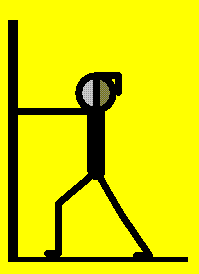
- Place your hands on wall with one leg to rear.
- Keep your rear leg locked straight and foot flat.
- Turn your rear foot toe forwards.
- Bend your front leg, taking the calf stretch through the rear calf.
- Change legs and repeat
- Keep the toes of both feet facing forwards.
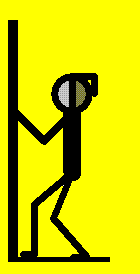
- Place your hands on the wall, taking the weight through your rear leg.
- Turn your rear foot slightly inwards and keep your heel flat.
- Bend your rear knee forward over your rear foot.
- Change leg and repeat.
- Keep the toes of both feet facing forwards.
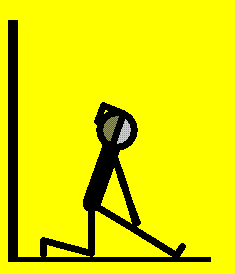
- Kneel on one leg with your other leg straight out in front with the foot flexed, and toe upright.
- Keep your back straight.
- Bend forward at the hips.
- Slide hands down leg towards foot and feel the stretch down the back of your leg.
- Change leg and repeat.
- Keep toe upright, back straight.
- Only go as far as is comfortable, it is not necessary to touch the toes
- An alternative is to stand and support the leg to be stretched on an object that is lower than hip height. In this case the foot on the ground should be at right angles to the leg being stretched and the standing leg slightly flexed.
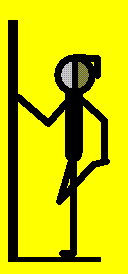
- Stand up straight, feet together, then bend one leg so as to lift one foot upwards and backwards while balancing on the other leg.
- Keep your knees close together and in line throughout the stretch.
- Lift the foot rearwards and upwards, pulling the heel towards your buttock.
- Maintain the knee position, close together and in line.
- Keep your back straight.
- Change leg and repeat.
- Keep back straight and stomach flat, do not allow hips to tilt as heal moves rearward and up
- Keep knees as close together as possible
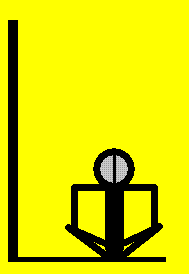
- Sit on the floor with your back straight, legs bent, knees outwards with the soles of feet touching each other.
- Grasp your ankles and draw the heals of both feet in towards your groin.
- Keep the knees outwards and down by using your elbows or hands to apply a gradual downward and outward pressure on your knees.
- Apply only a slight downwards pressure to the knees to achieve the stretch and keep them from rising.
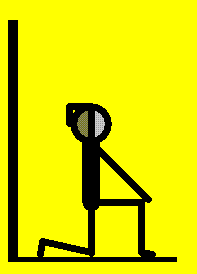
- Kneel, with one knee on ground, the other leg bent with the foot flat on the ground forwards of the knee on the ground.
- begin with the knees at right angles.
- Make yourself tall, tilt your pelvis forwards by moving the bottom of the pelvis forwards.
- Keep your back straight and head up.
- Change leg and repeat.
- Maintain abdominal tension and minimize trunk/torso movement.
- Additional stretch can be achieved by a slight front wards movement of the forward knee.
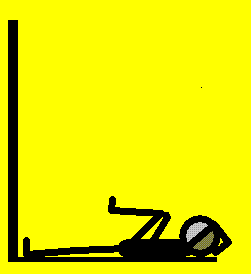
Part 1. The Gluteal: - Lie on your back with both hands around one knee.
- Pull your knee towards your opposite shoulder.
- Keep your head, shoulder and opposite leg relaxed.
- Change knee and repeat.
- Apply each stretch slowly - take it to where tension can be felt, but not pain.
Part 2. The Piriformis: - Lie on your back.
- Hold your knee to your chest.
- Pull your knee and ankle towards your opposite shoulder.
- Change knee and repeat.
- Apply each stretch slowly - take it to where tension can be felt, but not pain.
8. Lower Back (Cobra):
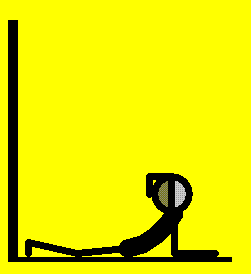
- Lie face down, legs straight, feet and knees together, arms out with elbows at shoulder height.
- Lift head and shoulders off the ground, assisted by pushing with arms, arching back.
- With weight from shoulders supported with elbows on the ground, allow the back to sag, hips remaining on the ground.
- Support weight through the shoulders and the arms, keeping the forearm and hands on the ground.
- Only push upwards sufficient for the back to be arched, normally no higher than elbows on the ground.
- The hips remain in contact with the ground throughout the stretch
9. Trunk Side Flexor:
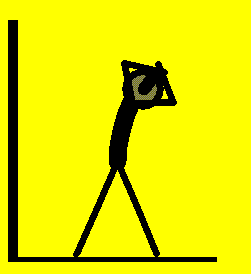
- Stand with your feet comfortably apart.
- Fold your arms above your head.
- Bend to the side slowly.
- Keeping the arms folded, extend upwards with the upper most elbow.
- Change sides and repeat.
- Maintain abdominal tension and minimize trunk/torso movement.
- Keep both feet flat on the ground, do not let the heals rise of the ground.
10. Triceps Muscles:
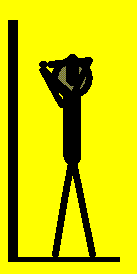
- Move your hand over your head to place your hand between shoulder blades.
- Lift the elbow high to get the hand as low as possible behind the back.
- Place your opposite hand on your elbow.
- Use your hand to move the elbow slightly towards your body midline (inwards and rearwards) so the of the arm behind your back is closer to the vertical position.
- Change arms and repeat.
- Keep head up and maintain abdominal tension and minimize trunk/torso movement.
- Keep both feet flat on the ground.
11. Pectoral Muscles:
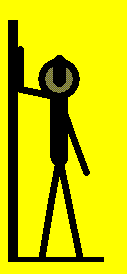
- Stand side-on to a wall.
- Move the leg closest to the wall forward.
- Place your forearm on the wall with your elbow slightly above shoulder height (elbow slightly more than a right angle).
- Maintain the forearm and elbow against the wall then turn your upper body away from wall.
- Maintain abdominal tension and minimize trunk/torso movement.
- Keep both feet flat on the ground, do not let the heals rise of the ground.
12. Bicep and Deltoid Muscles:
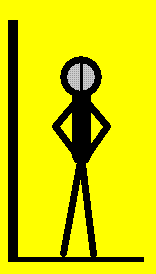
- Stand with your head up, chin in, hands clasped behind your back.
- Feet, shoulder width apart.
- Pull your shoulders backwards and down.
- Press your shoulder blades together and down.
- Pull your stomach in, to prevent arching of the lower back.
- Maintain abdominal tension and minimize trunk/torso movement.
- Keep both feet flat on the ground.